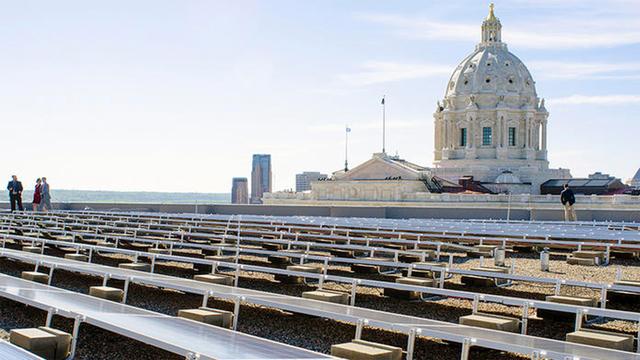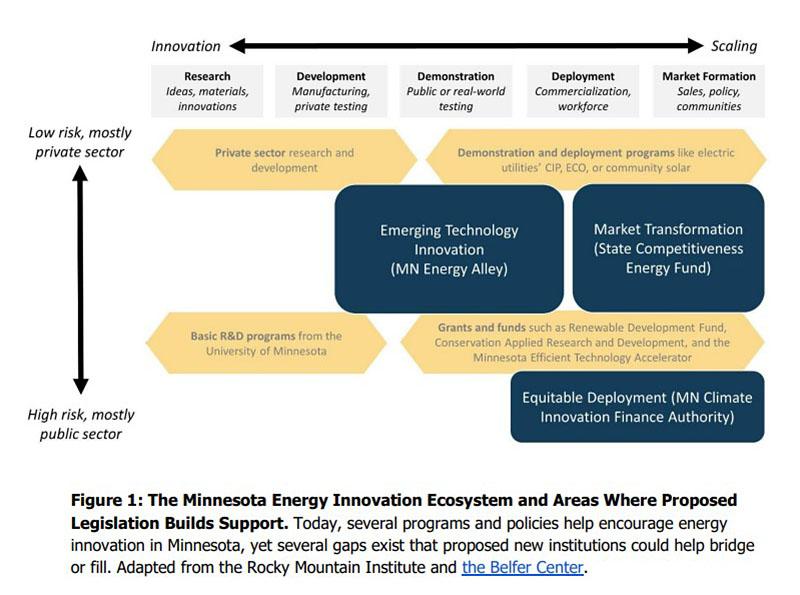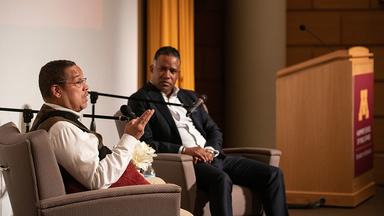By Associate Professor Gabriel Chan and Research Fellow Matt Grimley, Center for Science, Technology, and Environmental Policy, Humphrey School of Public Affairs
Minnesota has long been a leader in clean energy, with one of the United States’ first renewable energy standards and strongest efficiency policies.
Now with a 100% clean electricity standard and federal legislation poised to unlock clean energy investment opportunities (the Infrastructure Investment and Jobs Act and the Inflation Reduction Act), the state has an opportunity to create new institutional support to increase clean energy funding, economic competitiveness, and equitable access and outcomes in the state.
Based on our past research, we believe clean energy legislation can fill important gaps in Minnesota’s energy innovation system by focusing on three functions:
- Technology innovation
- Market transformation
- Equitable deployment
These three areas can be bolstered by current proposals in the Minnesota Senate and House omnibus bills that support the MN Energy Alley (SF2249, HF2524), the State Competitiveness Energy Fund (SF1622, HF1656), and the MN Climate Innovation Finance Authority (SF2301, HF2336), respectively.
The recipe for clean energy innovation
Clean energy innovation is like a good hotdish: it needs layers. Typically, innovation works from basic research and development (where scientists conduct high-risk, high-reward experiments with no specific market goal) to deployment (where policies focus on getting specific technology to market). Scaling technologies and innovations means building support along the path from the lab to market.
The state has a robust set of private businesses, universities, state policies, and funds that support private and public-sector innovation along the path of innovation. But Minnesota will need to innovate smarter and faster to meet the state’s carbon goals, maximize the potential of federal investments, and deploy technologies equitably.
To boost Minnesota’s innovation and deployment ecosystem, the clean energy innovation “recipe” needs to be fortified at each layer with a portfolio of low-risk and high-risk investments across emerging technology research and development, market transformation, and equitable deployment (Figure 1).
In bolstering public support for energy innovation, the federal government and other leading states take a layered approach to working across the public and private sectors to build institutional capacity to fill the gaps between existing public institutions, philanthropy, and the private sector.
Without filling these gaps, promising innovations can succumb to a “valley of death,” failing to advance from one innovation stage to another, and ultimately failing to contribute to the state’s policy goals of equitable deployment of clean energy technologies.
• Emerging technology innovation is often accomplished in other states through a mix of public and private accelerators and incubators that connect start-ups and their technologies to industry partners. These programs are meant to bring researchers and engineers together to develop technologies to the point where they can be commercialized by the private sector.
Connecting basic and applied R&D programs can be bolstered by the Minnesota Energy Alley legislation, helping to support the manufacturing, testing, and demonstration of new, viable technologies, while creating a new generation of Minnesotan innovators and locally based clean energy companies and jobs.
• Market transformation happens as the public sector supports the private sector in deploying new technology. Market transformation efforts require reducing systemic barriers that can catalyze clean energy deployment and allow for self-sustaining deployment by the private sector.
Market transformation in other states focuses on building the capacity of utilities, contractors, developers, and other businesses to bridge real-world deployment with the demands of our quickening energy transition. Activities can include catalyzing initial deployment to build economies of scale, creating demonstration projects, and developing information and analysis tools.
The proposed State Competitiveness Fund does this at a high level by providing funds to state, local, and tribal governments, along with electric utilities, for matching grants from the Infrastructure Investment and Jobs Act and the Inflation Reduction Act. And the Minnesota Climate Innovation Finance Authority can further bolster market transformation for a broader set of communities.
• Equitable deployment is necessary to address head on because energy technology deployment often works through technically savvy existing organizations like utilities and local governments, but misses grassroots innovations at the household, community, small business, and nonprofit levels.
To fully capture the potential of clean energy technology to create equitable benefits for all Minnesotans, particular attention is needed to lower the capital costs of energy customers and contractors that are working at a smaller scale, particularly with disadvantaged communities.
The Minnesota Climate Innovation Finance Authority programs could promote job growth, equity, and justice, and bridge across sectors for different decarbonization programs.
Don’t skimp on the clean energy hotdish
With proposed legislation to create three new energy innovation institutions this session, Minnesota has the opportunity to create its own version of a layered innovation system. Such a layered approach can help to build complementarities across the state’s energy innovation system among institutions that support each other, rather than compete or ignore each other. And just like with an excellent hotdish, building layers of a Minnesota innovation system that works together can make the sum greater than its parts.
For example, pairing targeted support for equitable deployment of clean energy technologies through the MN Climate Innovation Finance Authority with state-backed cost sharing through the State Competitiveness Fund can make Minnesota more competitive for federal funding opportunities that require both matching funds and compliance with the goals of the Justice40 Initiative, which will bring resources to communities most impacted by climate change, pollution, and environmental hazards.
For the state of Minnesota, and the nation as a whole, this is a pivotal time in our clean energy transformation. Billions of dollars in funds and incentives are rolling down from the federal government.
If the state and its numerous businesses and nonprofits aren’t ready to capture these opportunities, Minnesota is at risk of falling behind in economic development, technology innovation, and the opportunity to grow clean energy with our underserved communities.
Clean energy innovation and deployment require layers of public and private support. They also require we don’t skimp on supporting such a recipe.
Funding, staffing, and continuity for our clean energy institutions will ensure that they can grow and nurture the state through what will be an exciting, eventful, and interesting future.





